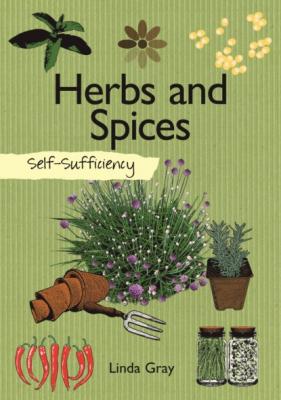Self-Sufficiency: Herbs and Spices. Linda Gray
Читать онлайн.| Название | Self-Sufficiency: Herbs and Spices |
|---|---|
| Автор произведения | Linda Gray |
| Жанр | Дом и Семья: прочее |
| Серия | |
| Издательство | Дом и Семья: прочее |
| Год выпуска | 0 |
| isbn | 9781607659365 |
Published 2019—IMM Lifestyle Books
IMM Lifestyle Books are distributed in the UK by Grantham Book Service, Trent Road, Grantham, Lincolnshire, NG31 7XQ.
In North America, IMM Lifestyle Books are distributed by Fox Chapel Publishing, 903 Square Street, Mount Joy, PA 17552, www.FoxChapelPublishing.com.
© 2011, 2019 by Linda Gray and IMM Lifestyle Books
Produced under license.
All rights reserved. No part of this publication may be reproduced, stored in a retrieval system or transmitted, in any form or by any means, electronic, mechanical, photocopying, recording or otherwise, without the prior written permission of Fox Chapel Publishing.
Print ISBN 978-1-5048-0058-7
eISBN 978-1-6076-5936-5
We are always looking for talented authors. To submit an idea, please send a brief inquiry to [email protected].
This book has been published with the intent to provide accurate and authoritative information in regard to the subject matter within. While every precaution has been taken in the preparation of this book, the author and publisher expressly disclaim any responsibility for any errors, omissions, or adverse effects arising from the use or application of the information contained herein.
CONTENTS
INTRODUCTION
Over the past couple of decades or so, processed sugars and excess salt have infiltrated our diets and changed the way we perceive pleasurable tastes. The increased focus on healthy eating and the vogue for growing your own food has helped promote the idea of exploring new tastes, and steering the family’s taste buds away from sugary snacks to appreciating good food and natural flavours.
Herbs and spices that you grow yourself can do just that, and even if you have never grown a plant before, herbs are a good place to start, whether you have a large garden or just an available windowsill.
The difference between herbs and spices is simply the part of the plant used. The leaves and flowers of plants are generally regarded as the herbs while the seeds, roots, stigmas and even bark are considered to be spices.
For many thousands of years, herbs have been considered magical plants – humans have used them for millennia as food and as medicine. Those who knew what to do with herbs were sometimes treated with suspicion and sometimes revered. Spices, on the other hand, were shrouded in mystery until recent times – their exotic nature and origins were mythologized by the spice traders over the centuries to keep the prices as high as possible.
In our present information-packed world we can have it all, and growing herbs and spices at home is one of the most satisfying projects anyone can take on. The wonderful tastes of herbs and spices can encourage even the most jaded palate to enjoy good food again. And the more good food we eat the less we want the stuff that is not so good for us.
Planning your herb garden
There is a lot to be said for letting your garden grow wild to provide a mini ecosystem for bees, butterflies and wildflowers; however, if you actually want to produce crops for you and your family to eat, it’s necessary to do a little planning.
How to begin
Herbs and spices can be grown in different places around the garden; for example, it’s always a good idea to have a basil plant growing with your tomatoes every year, but many herbs are perennial and will benefit from having their own space. A custom-made herb garden can thrive for years with very little maintenance, given the right conditions and a little TLC from time to time. One of the best ways to maintain herbs is to actually pick them and use them; it is easy to overlook small herbs but most will benefit if used regularly.
Herbs and spices are very accommodating plants and most will be happy in containers, so if you are short of outdoor garden space, growing in pots is an ideal alternative.
As with any sort of gardening, it’s best to first decide what you want to grow and then do a little research to make sure it’s feasible in your part of the world – growing mangos outdoors in a cool, temperate climate is probably a non-starter.
What to grow
The first step to planning your herb garden is to decide what to grow. Firstly, choose those herbs and spices your family likes to eat. The second consideration is your particular climate and soil and then the space you have available for this kind of project. The herbs and spices listed in this book are for culinary use, although most have other uses in preventative medicines and cures for minor ailments.
If you use a lot of tomatoes in the kitchen, then basil is a must in your herb garden since it enhances the flavour of tomatoes, especially home-grown ones. Basil is an annual herb in moderate climates and needs to be sown every year, but other herbs such as thyme, sage and mint will come up on their own year after year. Aloe vera is a useful herb, especially in the kitchen as the sap from the leaves can be used to soothe minor burns; it is grown commercially now for its healing properties and is added to many products.
Read through the descriptions and growing requirements of the herbs and spices in this book and note down the ones that appeal to you and those you think you might like to grow. A little planning goes a long way here, but don’t get bogged down in too much detail.
Where to grow
